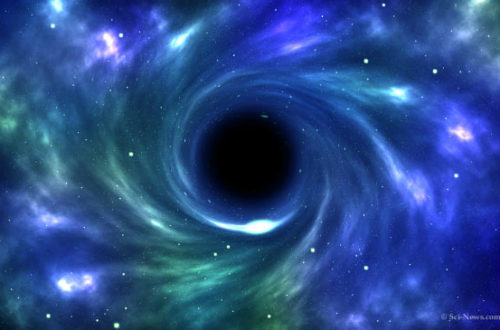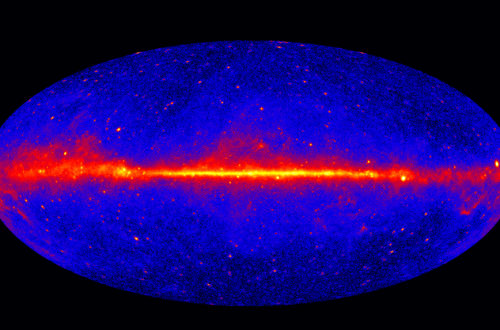Fantastic Beasts (and where to find them)
Most galaxies on our universe seem to harbor, at their center, the amazing beast known as a supermassive black hole (to know more about black holes see my previous post here). What do we mean by word supermassive? Astronomers compare the mass of most objects in the universe with the mass of the most massive object in our vicinity, i.e., our sun. Supermassive black holes are millions to billions of times more massive than our sun. To put it simply, millions of our suns together would weigh as much as these beasts! For a nice visualization see this link.
Light from the vicinity of these supermassive black holes (in galaxies near, far, and far-far away) takes billions of years to reach us (except from the one in our galaxy which is closer). But how do we know how heavy they are? We can’t just go to these beasts and ask them to stand on a weighing machine! (There are so many reasons why that won’t work, e.g. our supermassive black hole is still thousands of light years away so for humanity that’s a long trip and for any single human it’s a one way trip, you will need a weighing scale bigger than our solar system, plus putting the black hole on the scale is another issue…).
Astronomers have come up with ingenious ways to measure the masses of these black holes. One method is by tracking / observing the objects (stars, gas, dust etc.) orbiting the black hole. The motion of these objects are dictated by the laws of gravity which we can use to determine how massive the black hole is (for more detailed explanation click here). This method works very nicely when we can see (through the telescopes) the orbiting objects (e.g., stars etc) and can track them individually. However, the farther a galaxy lies the harder it becomes to track the orbiting stars, and thus the method loses its effectiveness. What astronomers use for measuring how heavy the supermassive black hole masses in distant galaxies is a technique called reverberation mapping.
Enough about these beasts in general, now let’s focus on our very own monster – Sagittarius A*.
Sagittarius A*
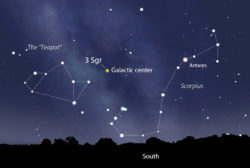
At the center of our Milky way galaxy and about 26000 light years away from us, resides our very own supermassive black hole which we call Sagittarius A* (Sgr A* in short). Why this name? Most astronomical objects acquire their name from their location in the night sky. What the name Sgr A* tells us is that this object is associated with the constellation of Sagittarius (see the night sky image). It kind of gives us a rough idea where to look to find it (there are many other objects in the Sagittarius constellation as well, so to accurately point to it we need the exact coordinates on the night sky). This nomenclature is generally true for many other objects in the night sky (e.g. how does one find the Andromeda galaxy – we can begin by looking in the constellation Andromeda, guess where the Orion nebula is located – inside Orion!)
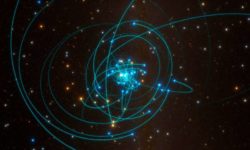
Measurements of orbits of several stars around Sgr A* has ascertained its mass to be about 4 million times the mass of our sun and in size it is as big as our solar system! Recent publications have offered some new insights into our very own beast and stars around it. The GRAVITY collaboration by using the GRAVITY instrument has been observing a star called S2 orbiting close to Sgr A*. This star takes 16 years to complete its highly elliptical (oval shaped) orbit around Sgr A*. This means that at times it moves far away from Sag A* but then it also comes pretty close. S2 star made its closest possible approach during May 2018 (at the point of closest approach S2 was orbiting at 7650 km/s)! This close approach of a star to a black hole provides a test of Einstein’s General Theory of Relativity (GR for short). Although GR has been successful in explaining several observed phenomena in the universe, it only takes one mismatch between theory and experiment to disprove a theory. Thus S2’s approach to the supermassive black hole was another opportunity to test GR around a black hole.
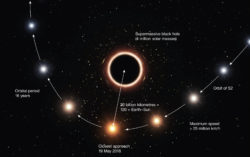
GR tells us how massive objects (like Sgr A*) bend space-time and what the consequences of that bending are. For e.g., one consequence is gravitational redshift, which means light produced close to such a massive object will lose some energy to escape from the gravitational influence of the massive object. Interestingly, the star S2 comes sufficiently enough to Sgr A* for GR effects like gravitational redshift to be important. And indeed, the light from S2 was observed to be red-shifted as predicted by the theory! Once again, Einstein’s GR has come out with flying colors!
Sgr A* also exhibits flaring activity – where for a brief period of time the electromagnetic radiation output from it increases. Another paper by the GRAVITY collaboration, discusses flares detected in May and July 2018. These flares were produced by a region called the ‘hot-spot’ – which are believed to be hot regions of gases orbiting the black hole. During the recent flares, this hot-spot zone was tracked and it was observed to orbit around the black hole. Furthermore, the electromagnetic radiation observed was also polarized which is a characteristic signature of Synchrotron radiation (electrons producing radiation due to their interaction with magnetic fields). The results provide evidence for the existence of the strong poloidal magnetic in the emission regions!
Science is awesome!

